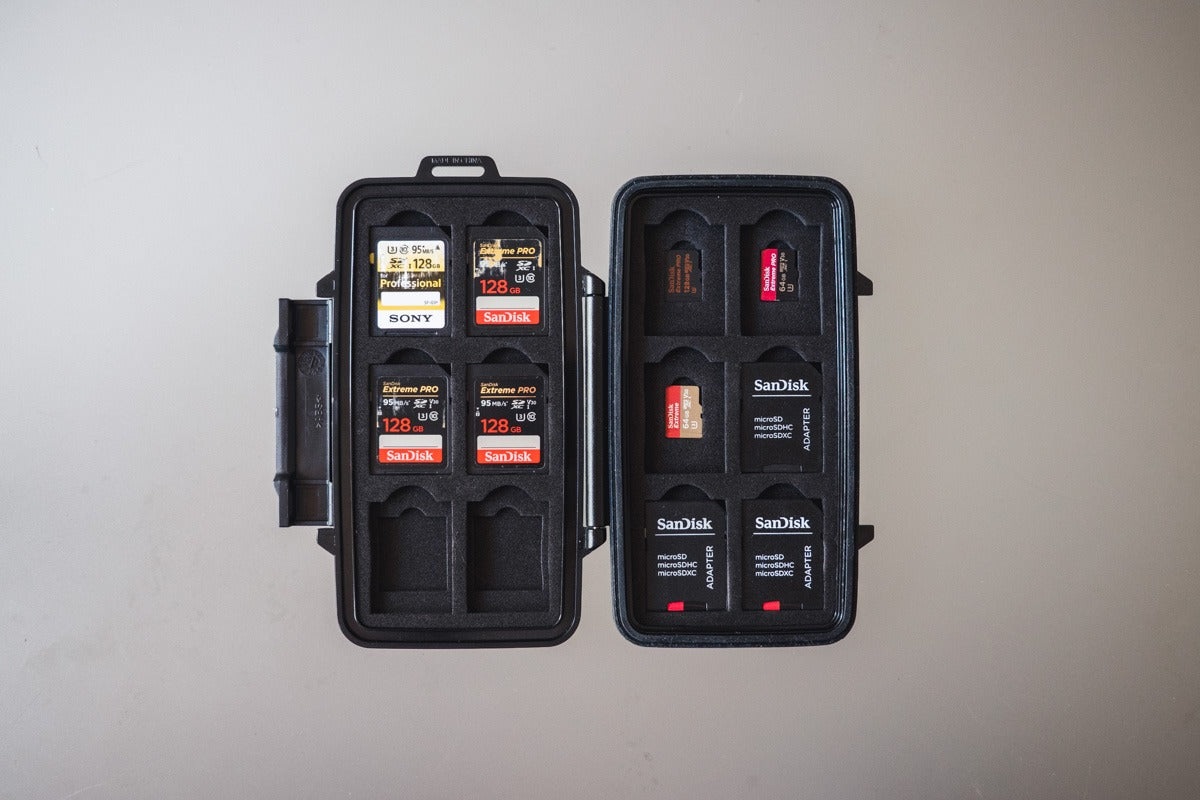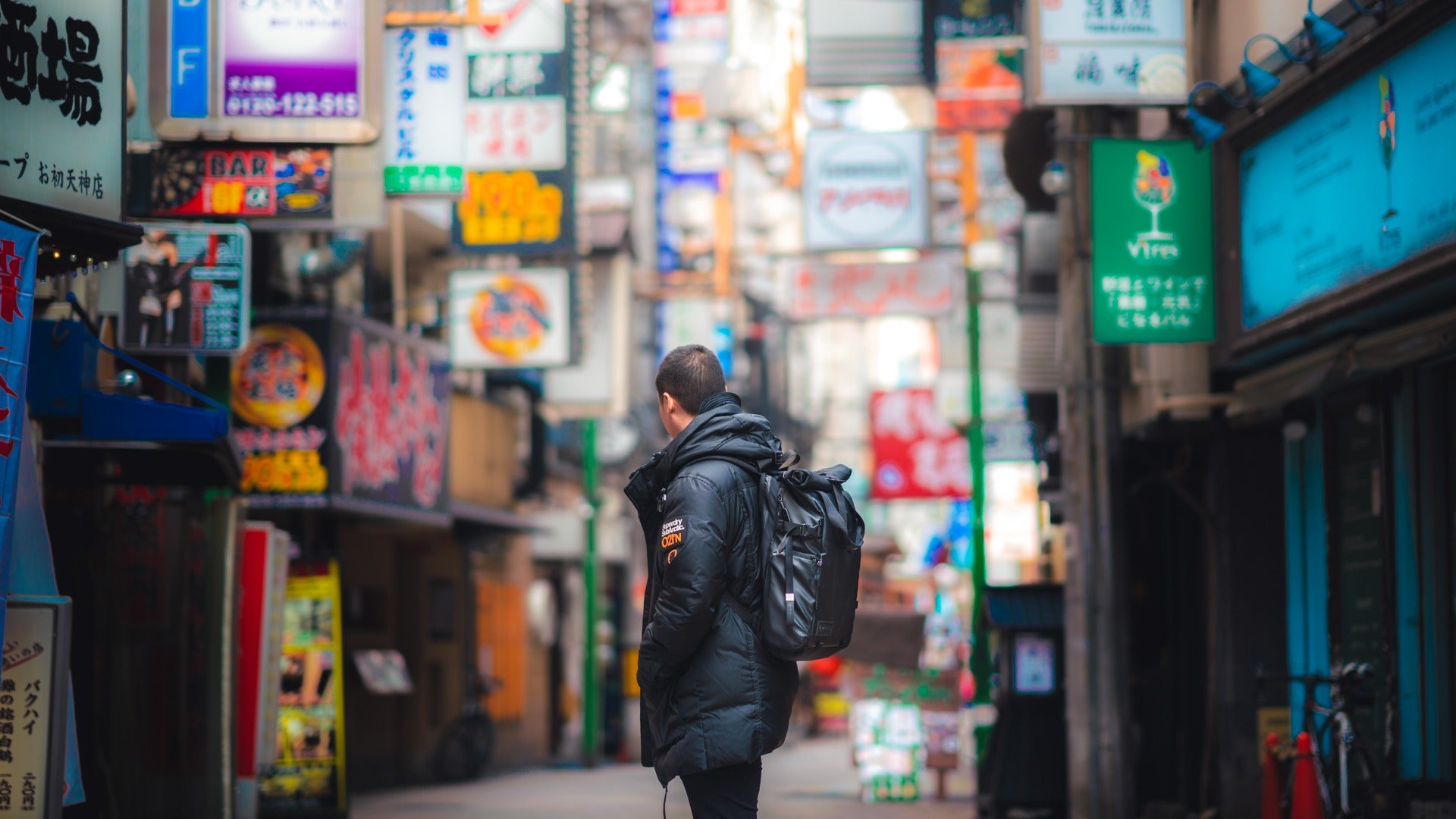The journey to finding the right gear for you never ends.
You’ll go through many kits, many lenses, many bodies, many theories, many opinions, many styles.
Primes vs zooms, DSLR vs Mirrorless, maximum coverage or maximum mobility. It goes on forever.
Throw in the fact that if you’re a Travel Photographer, you’re not just shooting landscapes every day. Some days you might shoot a portrait, or a street shot, some architecture or a cityscape. So it’s important you have the right gear to support how you do just that.
While there are many schools of thought on how to approach selecting the right gear, mine always revolves around how I “see” as a photographer - how I define my vision and the process behind capturing and image. It’s changed a lot. It doesn’t even start with the “subject” anymore (but describing this process is totally an entire blog post on its own).
Over time, I’ve started to notice patterns in my own work. I tend to see in either wide or tight. Typically anywhere between 12-35mm, or 85mm and up. Going back through my images, I find I rarely shoot between 36mm and 70mm.
I find I also tend to carry gear in 2 different ‘modes’ most often:
- Something fairly kitted up but also versatile and prioritising mobility
- Something super light and super nimble
It changes all the time, of course. Photography is a never ending cycle of improvement.
If you’ve never sat down to figure out how you tend to ‘see’ the world, how you like to capture images, or why you like to capture images, I’d recommend doing that first, so that you can then make the right purchase that enables you to do just that.

Main kit
This is the main gear that I run around with.
It provides me with a light pack so I can run around or hike all day without any back issues, yet it’s versatile with 2 bodies and a drone.
I don’t really use tripods, and I don’t often do long exposures. I’ll bring out a tripod and/or filters if I know I’ll need them in advance, though.
This setup optimises for maximum image quality through the beastly A7R 3 in conjunction with Sony’s sharpest zoom and sharpest prime. However it also has fantastic versatility and quality in video with the RX100VI added into the mix too.
All packed into the Wandrd Prvke, even with batteries, I’ve still got more than enough space for water, a change of clothes, any food I want to bring with me.
Sony A7R 3
My main camera.
Absolutely stunning detail, fantastic dynamic range, super fast autofocus and amazing battery life. Industry leading stills performance, fantastic video performance. Sony have really come a long way over the last couple of years. This the best camera for me, and one of, if not the best, camera on the market today for imaging.
Megapixel wise, the 42MP is important for me as I tend to do a lot of creative cropping in post. Otherwise, I could have easily gone with the A9 or A7 3.
Video wise, the new Alpha series line (A7 3, A7R 3, A9) has some of the best and most comprehensive features and performance in prosumer hybrid cameras on the market today. The competitor that come closes to it in this department is probably the Panasonic GH5, but that camera doesn’t hold a candle to the A7R 3 in the stills or autofocus department.
If you haven’t quite got the cash for the A7R 3, the A7 3 has tremendous bang for buck, and if you’re new to mirrorless, there’s no better option right now (even with all the new mirrorless offerings from the other camera brands).
Sony 16-35mm f2.8 G Master
My favourite lens because of how versatile it is. I love wide, contextual shots, and the 16-35mm GM helps me capture that. It’s Sony’s best performing zoom lens overall, with monster resolving power and a crazy level of sharpness.
I typically use it for capturing all kinds of scapes or (some) architecture. The 35mm focal length is a great walk-around length, and at f2.8, doubles as a great street photography lens.
Sony 85mm f1.4 G Master
The lens I have the most fun with.
I mostly use this lens for two styles. The first is street photography.
Combined with the super sticky continuous autofocus of the A7R 3, walking around using AF-C shooting at f1.4 is an absolute joy. When shooting portraits, the Eye-AF at f1.4 feels like cheating because of how good it is. Really a game changer.
The second is for landscapes. Surprise! 85mm is actually great for more detail-based landscape/compression shots. While it doesn’t offer the crazy range or compression a 70-200mm would give you, I find I don’t use anything further than 100-120mm as often as I could justify bringing my big 70-200mm with me.
However for those rare occasions where I do want to go 200mm, I use…

Sony RX100VI
This little guy is my ‘everywhere’ camera.
I bring it with me always. When it’s paired with the rest of my kit, it acts as a second camera so I can quickly capture a different focal length (usually far) without having to change lenses.
For situations where I can’t carry a big backpack or a big camera with me, I’m totally happy to use it just on its own.
I also sometimes pair it with the Mavic 2 Pro in my Peak Design 5L Sling for a super mobile setup that covers both the ground and the sky. Bonus points that they both use a similar 1” sensor.
The image quality from the RX100VI is fantastic. In all but really dark situations and aperture-dependent techniques, the image quality is indiscernible to that of a higher-end camera for most people. It’s really that good.
Pared with a super versatile 24-200mm equiv. Zeiss lens, fantastic 4k and 120fps @ 1080p slow mo video, this little pocket rocket has it all.

DJI Mavic 2 Pro
DJI’s latest and greatest is my newest replacement for my Phantom 4 Pro, Mavic Air and Mavic Pro.
With the Mavic 2 Pro, I can have both great portability and great image quality in a package that can easily fit into my backpack, and still have room for 3 extra batteries.
Check out the Mavic 2 Pro Review here.

Wandrd Prvke 21
The search for the perfect camera bag never ends.
I have many requirements when it comes to a good camera bag.
It needs to be durable. Very waterproof, if not water resistant. The main compartment needs to be only accessible from the back to prevent thieves and so I can lay it down without my back getting dirty. It needs to have quick camera side access. Space for a tripod. Customisable dividers. A laptop sleeve big enough for a 15” Macbook Pro. Comfy straps. Optional chest and waist harnesses. It needs to have a low profile. It needs to look good. It needs to come in black. And it needs to not scream ”I’m a camera bag”.
…just a few requirements.
Thankfully, this bag actually does all of those things pretty well.
I’ve actually been really happy with this bag so far. It’s not perfect. I have frustrations with the roll top and the silly magnetic clasp that sits over the top of it. But otherwise, it has a lot of compartments, great dividers, well organised internals, super comfy shoulder straps, and it looks good while having all that. Win.
Optional/situational
These are the things I bring with me on occasion.
If I know I’m going to need them because I know ahead of time what I’m going to shoot, or if I need to travel light, or shoot in the dark etc, these are things I occasionally bring with me.

RX1R M2
A full frame camera in a compact (yes, a real compact) form factor. A feat of engineering in my eyes.
With a fixed 35mm f2.0 lens and the same sensor from the A7R 2, the RX1R M2 is a beast that can kinda fit in your pocket (or at least your jacket pocket).
The 35mm focal length is a super versatile length good for capturing almost all styles of photography bar architecture.
I usually bring it with me if I only want one camera, or if I’m shooting street photography with the 85mm on the A7R 3 and want a second camera to shoot at 35mm really quickly with.
Check out a review on the RX1R M2 I did over at my personal site.
70-200mm f2.8 G Master
This lens used to be my number 1 go to, but as my style has evolved, has since fallen out of the top 2 spots and only occasionally gets a run.
It’s damn sharp and very versatile, giving you perspectives and a range you can’t see with your eyes normally.
However, it’s heavy. I found myself not using anything over 120mmish that often to justify bringing it with me all the time. I swapped it out for the 85mm f1.4 GM and haven’t looked back since.
If I ever need the reach though, my RX100VI goes to 200mm and that quality is more than good enough for me for most cases.
12-24mm f4 G
Mostly used for architecture.
It’s a decent lens, plenty sharp. However it doesn’t come close to as contrasty, sharp or punchy as the 16-35mm GM. They’re in completely seperate leagues. Therefore I only ever use this lens when I need to shoot tight spaces, architecture or interiors, and I only ever use the 12-16mm portion of it really.
35mm f1.4 Zeiss
Ever since I got the RX1R M2, I’ve not found a use for my trusty 35mm f1.4 except for video.
The Zeiss has a fantastic punchy, contrasty look to it, and combined with the f1.4, makes video scenes really pop with little post processing.
I feel bad for it because it sits on the shelf most of the time, but I love it all the same.
Sirui T-025
Being lightweight for me means a lot.
I’ve been through many tripods in the search for the ultimate travel tripod, and I think I’ve found it.
This little guy is tiny. With its carbon fibre legs, it’s super light, but it’s also really sturdy. The ball head is also really strong; strong enough to sturdily hold an A7R 3 + 70-200mm GM if I ever want to do long distance long exposure shots.
Great peace of mind.
Joby Gorillapod 5K
This thing rarely gets a run because I don’t vlog, but it does come in handy every now and then if I know I’m going to be doing long exposures in tight spaces or on a balcony or something.
Accessories
Of course, there’s a bunch of extras I’ll carry with me that are necessities to my photography experience.
Peak design leash
For me, hands down, the single best camera strap there is.
It’s thin, it’s light, its strong. Adjustable to a shoulder strap or a neck strap or even wrap it around your wrist a few times for a wrist strap.
Having owned both the Slide and SlideLITE, once I went to the leash I never looked back. For me, it has the best balance of lightness and security - especially on a mirrorless system.
Peak design cuff
For the times where I want to be a little more ‘hands on’ with my capturing. Usually in cities.
I also use it a lot when I’ve got two cameras out at the same time capturing different focal lengths. This way I’m secured from accidental drops or theft on both systems.

Sandisk Extreme 900 SSD
One of the fastest, most robust high-end external SSD you can buy and hands down the best SSD for photographers and videographers. I use the 1.92TB version.
With an insane actual real world 850mb/s read and write speed, it’s over twice as fast real world than the Samsung T5 everyone seems to love.
Not only that, but it looks sleek, with an impact and temperature resistant aluminium exterior shell to boot.
It does have the price tag to go with those features, but when it comes to hard drives and memory in general, don’t skimp out. For some people, your livelihood depends on these things.
I’ve actually got two since they’re so damn good. A working drive for stills and a working drive for video.
Sandisk Extreme Pro USB
This little speed demon is just always in my bag incase I need a flash drive. Sometimes it’s used as a 3rd backup on short trips. I use the 256GB version.
It’s one of those things you don’t need all the time, but will be glad to have when you do need it.
Sandisk Extreme Pro SDXC 128GB
Noticing the Sandisk Extreme Pro trend here?
This article isn’t sponsored or anything, I just genuinely love the Extreme pro line. It was made specifically for pros across the entire spectrum of photography and videography.
I have 5 128gb cards because I don’t delete my images when I’m on a trip. I use the SD card as a backup option and only format the card when the content is stored on my working drive, an archive drive, and also backed up into the cloud.
…and no, 4 levels of redundancy is not too much
Sandisk Extreme Pro SDXC 64GB
I have a bunch of these cards too for shorter trips.
Typically a 64GB card might get me through a day or two, but if it’s a short trip I tend to swap over SD cards every day as an added level of protection.
Also, I use a combination of normal size SD and Micro SD cards so that I can swap them between my hand held cameras and my drone for reuse.

Pelican SD card case
Again, I take my memory pretty seriously, so I house my SD cards in a water resistant, shock proof Pelican SD card case.
It’s great. It stores both micro and regular SD cards and has a strap attachment so you can strap it to your bag and not lose it.
Rocket blower
Gotta keep clean!
The rocket blower is a classic staple that ensures you’re only blowing air with no dust onto things like your sensor or lens.
Don’t cheap out on this. Those cheap knockoffs will blow crap and dust all over your valuables.
Anker PowerCore 10000
One of the best power banks on the market.
It’s tiny, sleek, and charges my devices super fast. I never leave home without it. Useful for charging my phone or any of my cameras through USB.
Batteries
I tend to always bring all my drone batteries with me when I carry my drone. That means 3 additional units. They’re big, but most of the time it’s worth it for the 2 hours of flight time I’ll get.
The Z-type batteries on the A7R 3 I rarely have to change. I might have 1 ‘just incase’, but really, 1 battery is enough to last through a day and a half of hard shooting in most cases.
The NP BX-1 batteries for the RX100VI and RX1R M2 are a different story though.
Those cameras are power hungry. and the batteries are tiny. I might be able to stretch one battery for a day if it’s a second shooter and only shooting stills, but if I’m shooting video, I could potentially go through a few in a day.
Good thing they’re tiny though. Easy enough to bring a half dozen around with me at all times.
B+W and Breakthrough photography filters
A lot of people ask me what type of filters I use.
Honestly, I rarely use filters for anything but video.
For video, I have a few B+W XS-Pro variable ND filters in a few filter thread sizes. They’re great. Super sharp, no colour cast, no ‘X-ing’ at the end of the range, very convenient.
For the rare occasion I do want to use ND filters for photography, I have a set of X4 ND filters by Breakthrough Photography. Again, they’re super sharp with no colour cast. I use the twist on versions so I can stack them together and keep them in a small package.
Digital
Aside from the Macbook Pro, these things aren’t in my bag, but they’re core to my overall photography workflow. You might find them interesting anyway.
Macbook Pro
I have the 2017 black touchbar version.
The touchbar sucks, but the rest of it is great. It has a matte black skin on it by Slickwraps because, you know, all black everything always.
I’ve been a Mac user since I was a kid and will probably be one till I’m old and grey.
Dropbox
I use Dropbox for all my backups and sharing with clients and friends.
I occasionally use the included app Paper for collaboration, and I use Showcase for client work wrap-ups and overviews.
Adobe Lightroom
My main source of photo editing.
I don’t do any sort of heavy manipulation on any of my images. What you see is what you get. I may take an image into Photoshop occasionally to remove bits of trash or random ugly things in the frame, but that’s about it. The majority will always be untouched.
I’m still on Lightroom Classic because the new Lightroom CC isn’t as powerful. It’s also expensive, and migrating everything over is hard.
Once they fix all those issues I may switch over, though.
Lightroom presets
I actually don’t use presets in the way most people use them.
I use them by components, layering on my own pre-made sets of tweaks one at a time.
I do get a lot of people asking me to make some full sets though, here’s my preset store if you’re interested in them.
Wrap-up
Ok, that’s it!
My gear reflects how I typically approach capturing images. I prefer being mobile, having the highest quality, and am obsessed about doing more things with less stuff. Every item here is carefully chosen and is the best I can find in that category. It’s earned its place and is the best fit for me.
Let me know what you think! Do you use any of this gear? Happy to answer any more questions you have about any of it!
Please note that some of the links in this article are affiliate links. They don't cost you anything to use, but they support the site, so please consider using them if this article inspires you to purchase anything 😊



